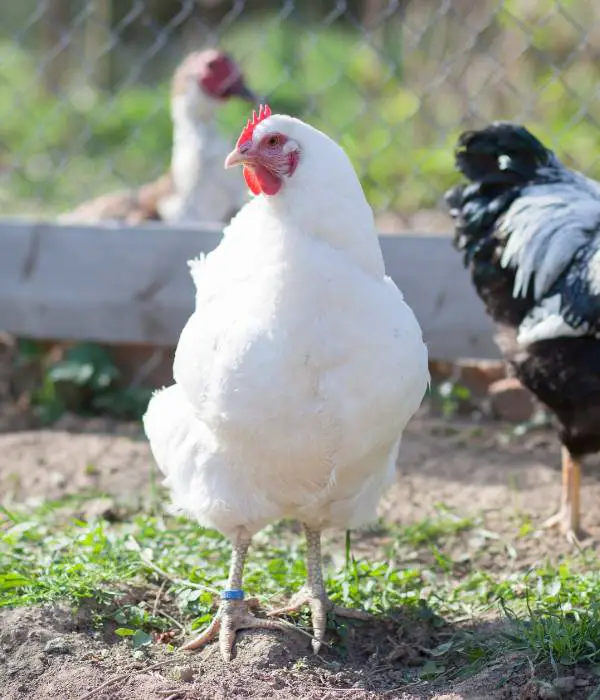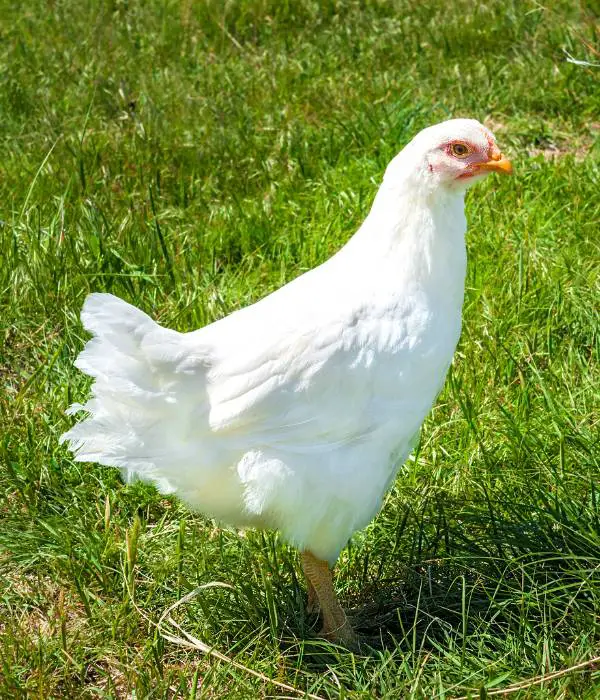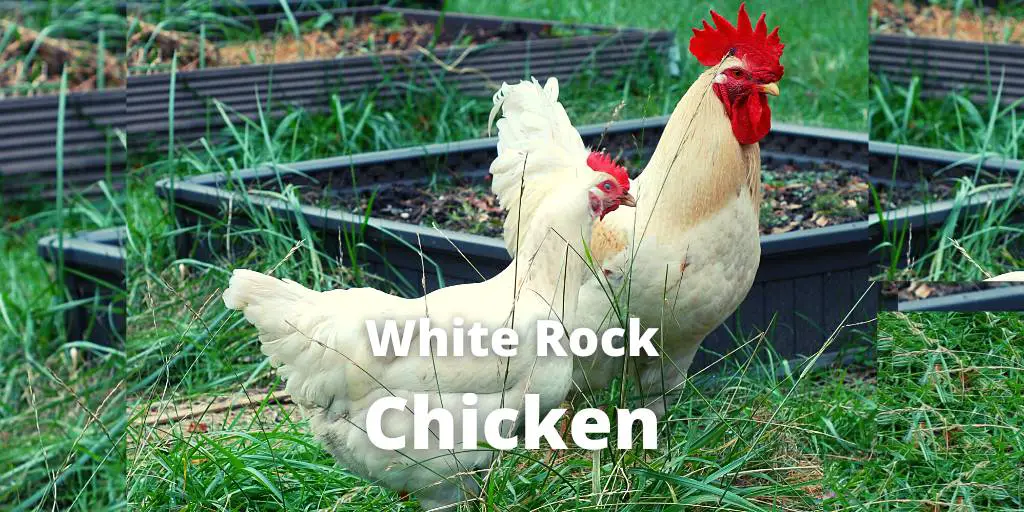The White Rock chicken has existed for over a century, and just like its name, it is brightly white and quite breathtaking. It is a variety of popular Plymouth Rocks.
So, the White Plymouth Rock and White Rock are the same. Like Black Silkie, Blue Silkie, these are White Plymouth Rock. They are not a complete white chicken breed.
The short name become popular by breeders later, but earlier people recognize them as White Plymouth Rock chickens.
The White Rock chicken is widely known for its dual purpose of laying quality eggs and being great in meat production.
So, most of the homesteader in The United States love to raise them in their backyard.
The History and Origins of White Rock chicken

The White Rock chicken is an American breed that originated in Massachusetts in the nineteenth century. In 1849 in Boston, the White Rock chicken was first seen and then disappeared for about 20 years.
Later, it was crossed with the Black Java to make a breed that was great at producing meat and laying eggs. So, in 1869 the White Rocks are again back as an efficient egg layers and meat chicken.
The dual-purpose use is the prime reason for the popularity of White Rock chickens.
Lifespan of White Rock chickens
White Rock chicken lives for about 8 years. This life expectancy is with proper care, a predator-proof, and disease-free environment.
White Rock chicken temperament
The White Rock chicken is friendly and effortless to train and tame. They are the best option for backyard chickens and make good pets too, as they are not aggressive.
They are quite docile too and not good at flying, so they do not need a lot of space. However, they do enjoy running and are good at foraging.
White Rock Hen Eggs: Laying Age, Count, Egg Size, and Egg Color
At about 5 months old, the matured hen will start laying eggs until they are 5 months old, when they will slow down the production.
This will be noticeable from the fourth year. As long as the hen is “happy and healthy”, the production should be one large egg in every twenty-four-hour period.
The White Rock hens produces about four eggs a week and about 220–260 eggs in a year. Typically, the eggs are large and brown.
White Rock chickens: color, size, appearance, characteristics
Color: The hen has snow-white feathering, just as its name implies.
Size: The female weighs about seven pounds, while the male weighs slightly above eight pounds.
Appearances: Due to an undercoat feather, the White Rock chicken has a fluffy appearance.
At the beginning of its life, its comb is orange in early days, which later turns bright-red when the hen begins laying eggs. Its beak is yellow, its wattles are red, and its eyes are orange-red.
The following are a few characteristics of the White Rock chicken:
- The White Rock chicken is quite a sight with its bright white feathers and bright red comb.
- It is a larger type of chicken due to its fluffy nature, more so during winter.
- It is docile and lives in a flock.
- The White Rock chicken is a dual-purpose bird, as it is an excellent egg layer that produces high-quality meat.
White Rock Hen vs. Rooster
Although the white Rock hen and the rooster look almost similar, there are several differences that can distinguish them.
Below is a discussion of the major differences between the female and male White Rock chickens.
Wattles and Combs: Wattles and combs-both the cockerel and hen have combs and wattles, but a mature rooster’s comb is bigger, brighter, and quite pronounced than in hens. Rooster wattles are larger, too.
Leg size: Male chicken legs are larger than female chicken legs. The male develops spurs that are sharp and pointed, which are an inch or more in length.
Behavior: Roosters tend to be more assertive in nature, bossy, and crow in the morning hours while the hen is somehow timid in nature. Roosters’ strength and stamina are greater compared to the hen.
Feathers: Neck feathers on a rooster tend to be longer and more pointed, while on a hen, they are shorter and rounder. Similarly, the roosters’ tail feathers are also longer and quite pointed.
White Rock chicken vs. Leghorn Chicken
White Rock chicken and Leghorn chicken are two different types of breeds, but it is quite difficult to distinguish as both have similar physical looks.
However, these two types have their differences, as discussed below.
Origin: The White Rock chicken originates from America, while Leghorn comes from Italy.
Production: The Leghorn chicken is mainly kept for egg production only. They are layer chickens, while the White Rock chicken is kept for meat, eggs, and also pet poultry.
Characteristics: The White Rock chicken is friendly, docile, and more inquisitive, while the Leghorn is a bit shy, more alert, and can be aggressive in nature.
Color and size of eggs: The eggs of a White Rock chicken are large and brown, while the eggs of a Leghorn are white and quite larger than compared to White Rock chickens.
Life Expectancy: The White Rock chicken can live up to eight or more years with proper care, while the Leghorn lives for about five years.
The Advantages of Breeding and Raising White Rock chickens

There are many benefits that one can enjoy if they raise and breed White Rock chickens. Some benefits of owning a White Rock chicken are as mentioned below.
1. They are friendly, docile, and easy to raise.
The White Rock chicken is quite friendly and social to humans, so it is easy to train and tame.
They are quite hardy and can adapt to various environments, so they can also be raised in the backyard, including in small spaces, as they have no tendency to fly.
2. They are productive.
The White Rock chicken is very productive as it can produce one large egg every twenty-four-hour period. Unlike other free-range chickens, they are easy to hatch from the eggs and grow quickly.
3. They are fast growers.
White Rock chickens grow rapidly and can be ready for egg production within six to seven months of hatching. The growth can be fast, and the chicken will grow to maturity in a short time.
4. They are excellent egg layers.
As compared to other chickens, White Rocks are good at laying eggs and are very prolific. They start laying eggs at the age of 5 months, and can lay eggs for four years before they get to their peak and slow down. A White Rock hen usually lays more than 250 eggs per year.
5. They produce high-quality meat.
A White Rock chicken is a dual-purpose breed, as they are excellent layers and also good at producing high-quality meat.
They are not only suited for eggs, but can also be used for food production. Meat from this breed is tasty, tender, juicy, and has a rich flavor. White Rock chicken is a good choice for those who love to eat steaks and roasts.
6. They make excellent pets.
White Rock chickens are docile and friendly; therefore, they can make excellent pets for both children and adults. They make excellent companion animals and can be kept as house pets.
They are friendly towards cats and dogs, but they are not likely to attack you or consider you a threat, unlike roosters.
7. They don’t need extensive space to grow.
It will be a mistake to undersize the chicken. It does not need extensive space to grow and can be fully grown without any problems at a compact size.
8. They are easy to maintain
A White Rock chicken is not a hardy bird and can be prone to disease and cold weather. Thus, the requirements for keeping them are not as high as those of other birds of other breeds.
They are very friendly and easy to handle, so they don’t require extensive attention and care.
9. They are very smart in nature.
White Rock chickens are very smart in nature and can be trained to fly and peck at certain targets. They are very friendly, but can be a bit shy.
Care should be taken when handling them as they tend to bite. With their beautiful appearances and mellow personalities, they are quite ideal for exhibition.
10. They don’t need extensive feeding for growth.
White Rock chickens can develop muscles quickly and hence do not require extensive feed for growth.
They have a high-protein content in their feed and, hence, will grow fast and be ready for egg production within a short period.
Problems in Raising White Rock chicken
Despite the advantages of raising White Rock chickens, there are also some problems that one might encounter.
Some of the common problems that are likely to occur in raising White Rock chickens include the following:
1. They are prone to disease.
A major issue while raising White Rock chickens is health issues, which are mostly brought on by an infestation of lice and parasites in poultry.
Treatment should be given as soon as possible. Apple cider vinegar is also recommended for the prevention of these parasites.
The White Rock chicken is a bit of a weak breed and thus is prone to diseases.
2. They do not like cold weather.
The White Rock chicken has not been bred for a long time; therefore, it might be hard to handle.
They are sensitive to cold and can even die when the temperature gets down to lower levels. If possible, keep the chickens indoors in the winter.
3. They are prone to low egg production.
The White Rock chicken does not lay as much as some other breeds. Therefore, if you want to get the most out of them, you should place them with another breed of chicken that is prolific at laying eggs.
4. They are not ideal for growing shows.
White Rock chickens are very docile and friendly, but they have no show qualities, and hence they should not be used to compete in poultry shows as they will not stand in comparison to other breeds of chickens.
5. They do not tolerate heat.
The white rock is a breed that has not been bred for long and hence it is not suited for hot weather and the temperature can go up to 40 °C. If possible, keep the birds indoors during the summer.
Other FAQs
Are White Rock chickens good layers?
Yes, the White Rock chicken is an excellent egg layer. They are known to lay as many as 150 eggs a week, with a high percentage of 50% of hens laying eggs.
How many eggs do White Rock chickens lay?
Of a year, White Rock chickens lay between 220 and 280 eggs. The number of eggs laid is dependent on the feed available to the chickens and the health of the chickens. The chickens can lay eggs for four years after they become mature.
When do White Rocks lay eggs?
Normally, the White Rock chicken lays one large-sized egg every twenty-four hours. You may find that some days they may not lay any eggs, due to their sporadic laying patterns.
How big do White Rock chickens get?
By maturity, the White Rock chicken is bigger than other standard-sized chickens, as it weighs approximately eight pounds.
The hen weighs about seven pounds while the rooster weighs eight pounds or slightly above at times.
Are White Rock chickens broody?
The White Rock chicken is a good mother. However, compared to the other breeds, such as the Orpington chicken, it does not go broody often.
She will, however, protect her chicks from threats, especially when left to raise them alone.
How long do White Rock chickens live?
The White Rock chicken typically lives for about eight years under proper care and adequate feeds.
However, they live longer if they are well nourished and cared for. They are sensitive to cold and can even die when the temperature goes down to lower levels.
Conclusion
Other than the information provided above, there is no other secret or trick to raise White Rock chicken. They are easy to maintain and can grow well in any given environment.
They require less space and feed, which makes them very convenient for use as a home pet. White Rock chickens are also very friendly and would be an ideal pet for both adults and children.


